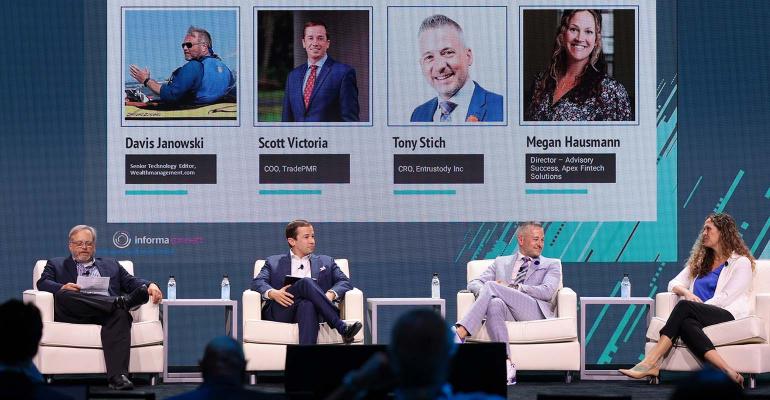As the dominant custodian for RIAs, Charles Schwab continues to digest its 2020, $26 billion acquisition of one-time rival TD Ameritrade. Seeing an opportunity, several smaller tech players have stepped forward to build custodial services using more nimble technology and a tighter focus on service.
Consider Altruist, the fintech firm that recently acquired custodian SSG, and Envestnet’s partnership with global wealth platform FNZ, after that firm acquired State Street’s wealth management custodial services. Goldman Sachs has launched a custodial service for independent advisors, and traditional independent broker/dealers like LPL Financial have also launched custodial services for unaffiliated RIAs.
“The custodian space is long overdue for disruption. They have long taken advantage of their customer, the advisor,” said Anthony Stich, an executive with recent custodial entrant Entrustody, speaking on a panel of emerging custodians at the Wealth Management EDGE conference at The Diplomat Beach Resort in Hollywood, Fla. this week.
In their pursuit of scale, the legacy custodians have “made concessions on the service model and the technology,” said Megan Hausmann, senior director for advisory success at Apex Fintech Solutions. That makes it a “great time for all of us to flex our muscles and see what we can do differently.”
Hausmann said the tech-forward custodians were in a good place to empower the “next great breakaway movement” of younger advisors who won’t tolerate the subpar technology and service levels coming from the larger incumbents.
The firms on the panel have an added advantage by not having a retail-facing business, unlike Charles Schwab and Fidelity. “We don’t compete with our advisors,” Hausmann said.
To be sure, the legacy custodians have the scale to provide RIAs more services at a cheaper cost than the newer entrants, and the capital to invest in technology.
Yet Scott Victoria, chief operating officer for TradePMR, pointed to the innovation happening at the smaller technology companies that can fuel an RIA’s growth.
“Our biggest focus is taking all of the superpowers, like digital account opening and fractional shares, and bringing those to advisors,” he said.
An emerging discussion among advisors is hidden costs to the end client imposed by the legacy custodian’s business models, Stich said. While the larger custodians say the service is free, the client ends up paying through operations like payment for order flow—which may give the client a worse execution price on investments—to the money a custodian makes by investing a client’s idle cash. By some estimates, a large custodian makes 15 basis points revenue on each client, with 9 basis points of profit.
“There’s an influx (of smaller advisors) that feel they don’t have a voice in that conversation,” Stich said.
The new breed of technology-first custodians hold out the promise of more nimble integrations into the tech stack and better service for frustrated advisors who call on them to move money between accounts or check on a trade or transaction.
“Our service philosophy is self-service technology,” said Hausmann. “The value-add is not being on the phone with the service team. It’s giving them the tools to do it themselves and spend more time on the phone with their clients.”
All panelists agreed a human is often still needed to field service requests, but said the tech means those employees would be better equipped to handle issues in a fraction of the time.
A $1 billion RIA today would be considered a small account at one of the dominant custodians, Stich said, and service requests from smaller advisors may not be prioritized. Entrustody promises to lean on natural language processing and artificial intelligence to make the advisor workflow more efficient and accurate and handle incoming service requests from advisors. Using AI, advisor clients will be able to move money between client accounts faster and with far fewer errors. “Traditionally that’s a 25-minute phone call.”
“There are 35,000 employees at Schwab, and (their service model) is a phone tree. Incredible,” he said.





